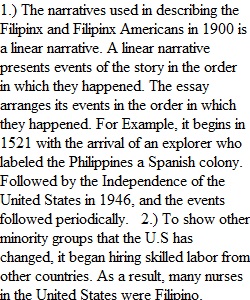


Q Instructions Below you will find the link to two very personal research projects from students last semester. Please click on the links and answer the questions below them. (the hyperlink will take you to a outside website where this reading is stored) Questions 1. What narratives were used describing Filipinx/Filipinx-Americans in the early 1900's. What self-interest shaped these narratives? 2. According the author, why are there a large number of Filipinx/Filipinx-American nurses in the United States? Make sure you explicitly address the policies shaping this history. 3. How has the model minority myth impacted Filipinx-American experience? 4. How did hte author struggle with their Filipinx-American identity? Questions 1. How did the Murillo v. Musegades case end racial profiling at public schools, and what constitutional amendment did these acts of racial profiling violate? 2. How did this case lead to Operation Blockade? Explain what operation blockade is. 3. How how has operation blockade failed to deter border crossing and dangers has it produced for those crossing the border?
View Related Questions